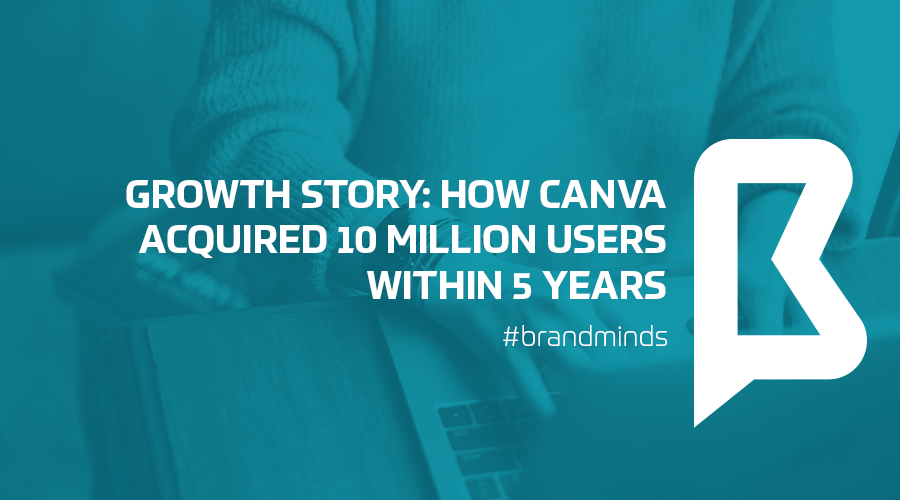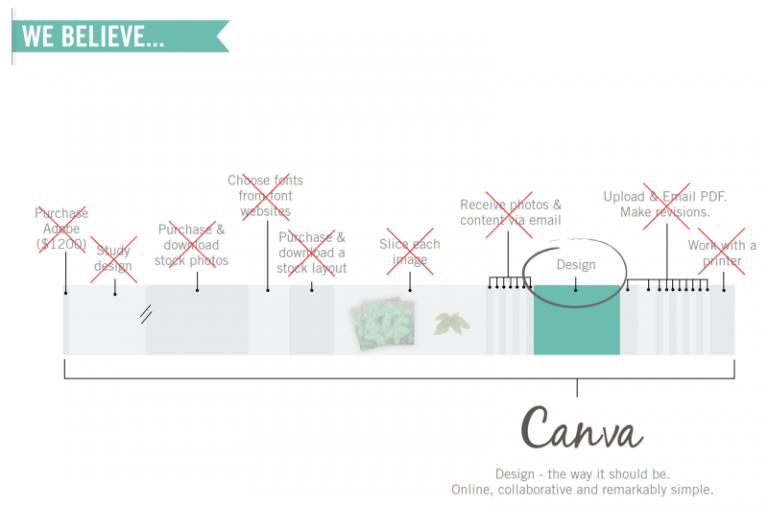Growth Story: How Canva Acquired 10 Million Users within 5 Years

There are 2 billion people on Facebook, 1 billion on Instagram and 500 million on LinkedIn. They use images to communicate and connect on all of these platforms but they are not photographers.
There are over 70 billion businesses using Facebook Pages, 25 million business profiles on Instagram and 18 million company pages on LinkedIn. Businesses hire social media managers to craft their presence and communicate with their followers. Although they are not graphic designers, their employers require them to have image designing abilities. Photoshop and Adobe are tools designed for professional graphic designers, but they are difficult to use by noobs.
What can individuals as well as communication professionals do beside going to graphic designing school?
They use Canva.
Our goal is to enable the whole world to design.
Melanie Perkins, CEO of Canva
Canva provides graphic design software as a service; it is an online collaborative platform dedicated to people who aren’t graphic designers and don’t have funds to hire one for their various needs.

Canva’s tools are simple and very easy to use, its interface is user-friendly and intuitive. The user is provided with a wide range of templates, fonts, colors and free photos to choose from. From Facebook covers to Instagram posts, brochures, infographics, logos, wedding programs etc – you can design anything and the end result looks amazing. Canva makes its users feel empowered to design and let their imagination translate into beautiful visual imagery and graphics.

Cliff Obrecht, Melanie Perkins and Cameron Adams/canva.com
Canva by numbers
Co-founders Melanie Perkins, Cliff Obrecht and tech expert Cameron Adams launched Canva in 2012 to selected professionals.
By January 2014, Canva had 150,000 users and opened publicly.
In April 2014 Guy Kawasaki joined the team as Canva’s Chief Evangelist; two months later the number of users tripled.
By October 2014 there were 1 million users who shared their Canva-designed images on social media, blogs, emails.
In August 2015, Canva announced it has reached 4 million users.
In 2017 the Australian startup reached profitability thanks to 294,000 paying customers.
To date, the do-it-yourself design platform has more than 10 million users across 179 countries with more than 100 million designs.
Canva’s founders raised $86 million since its launch and the company is currently valued at $1 billion.
Canva’s goal is to raise its users number to 3.2 billion (according to techcrunch.com).
- +10 million users
- +100 million designs
- 3 offices
- 200 team members
- $1 billion value

medium.com
Main reason for Canva’s success – a product which solves a problem people care about
While studying at the University of Western Australia, Melanie was teaching students how to use mainstream design software like inDesign and Photoshop, programs that people found hard to learn and even harder to use. She told bbc.com that “It could take a whole semester to learn the very basics. Even the simplest tasks, like exporting a high-quality PDF file, could take 22 clicks.”
You want to make sure that the solution you create, solves a problem that people care about. Find something that is truly significant. Find a problem faced by lots of people.
Melanie Perkins via forbes.com
She became aware she had just stumbled upon a business opportunity – the market needed a much simpler design tool and she was going to develop it. Melanie took her boyfriend Cliff on board and together started Fusion Books, an online design tool that made it easier for students and teachers to create their own yearbook. Fusion Books was a success, but Melanie and Cliff realised that the technology they had developed could be used much more broadly. They recruited Cameron Adams, Canva’s tech co-founder and the three of them began building Canva.

medium.com
4 strategies which supported Canva’s exponential growth
Canva never used paid advertising to tell prospects about its tool. The team developing Canva chose a different approach to grow the company.
1. Developing a great product, listening to user feedback and testing over and over again
Melanie and her team developed a good product but they postponed Canva’s launch to the public until they had a great product. After many months of continually refining, improving and testing the tools, they realised it’s not all about the digital tools, but also about empowering the users. Here is Melanie writing in her article about this moment:
It became quickly apparent that it was not just the tools themselves that were preventing people from creating great designs, but also people’s own belief that they can’t design.
In order for Canva to take off — we had to get every person who came into our product to have a great experience in a couple of minutes.
We needed to change their own self belief about their design abilities, we needed to give them design needs and we needed to make them feel happy and confident clicking around. We needed to get them to explore and play in Canva. No short order! So we spent months perfecting the onboarding experience paying particular attention to users’ emotional journey.
2. Word of mouth advertising and social currency
The 50,000 subscribers to Canva’s waiting list talked first about this amazing online design tool; this attracted early adopters, the first 150,000 people using Canva tools. These early adopters became Canva’s advertising engine by sharing their designs with their friends. Canva grew at a fast pace all through word of mouth and social proof.
Social currency in the sense of our community has always been incredibly valuable for us. More than 10 million people use Canva in 179 countries, and much of that growth has come through word of mouth and our users sharing about us.
Melanie Perkins via forbes.com
3. Influencer Advocacy
Guy Kawasaki learned about Canva through one member of his social media team who was using Canva to create graphics for his posts. When the people at Canva noticed Guy’s social media graphics were designed with their tools, they contacted him and so he became Chief Evangelist of Canva.
The reason Guy was attracted to Canva was that it “could democratise design just as Apple democratised computers and Google democratised information”. Guy Kawasaki coming to Canva and supporting it helped the online design platform double its users numbers.

Guy Kawasaki, Melanie Perkins and Cliff Obrecht/canva.com
4. Empowering content
Besides developing cool digital tools to support users craft wonderful graphics, Canva also empowers its users by helping them improve their designing skills.
Design School is Canva’s knowledge blog, the place where beginners and professionals come for design tips and inspiration. The blog is rich in resources such as tutorials and articles on how to design a brand, how to be more creative, what are the best resume or email templates etc.
One particular article, Benefits of Walking: Why the Greatest Minds take the Longest Walks, went viral with 90.5k shares on Facebook, 5.9k shares on Twitter and 2.4k shares on LinkedIn.
Did you like our article?
Share it with your friends!
5 Business Growth Secrets from Successful Entrepreneurs
One of the questions that most entrepreneurs ask is What drives business growth?
To help you grow your business, we put together the following list:
5 business growth secrets from successful entrepreneurs
Business growth secret #1 – Continuous learning

Grant Cardone/wallstreetoasis.com
At 23 Grant Cardone was a car salesman struggling with a drug addiction. He was a poor salesman, making only $300 a month. After getting clean of his drug addiction, he decided to become the best salesman though he didn’t like selling cars. To achieve his goal, he went all in. He spent all of his free time studying every sales book, sales training tape or sales course there was on the market at that time. He studied all the sales masters to learn everything he could. Every book, every line, and every piece of information – he turned them around and made them his own. He lived and breathed sales.
Within three years he was in top 1% of everybody in the automobile industry. He became a sales master at 29 years old. He was teaching other people about sales while actively doing sales every day.
In his fifties Grant Cardone is the best sales training expert in the world. He owns multiple successful companies whose annual revenues exceed $100 million.
Grand Cardone will be speaking at Brand Minds 2019, the Central and Eastern European Business Summit of the Year, on May 10th, in Bucharest.
Key takeaway: Find your subject of interest and go deep.
Business growth secret #2 – Get used to failing
What do all successful entrepreneurs have in common? It’s not their IQ, it’s not their talent or having lots of money. It’s grit.
Grit is a personal quality defined as perseverance and passion for long-term goals. Grit entails working with great effort and determination toward challenges. Another feature of grit is the ability to maintain effort and interest over years despite failure, adversity and plateaus in progress.
When people experience disappointments or boredom in their entrepreneurial endeavours, most of them change direction or abandon altogether. Unlike them, the gritty individuals stay the course. Think Elon Musk, Steve Jobs and Jack Ma: faced with one failure after another, they didn’t surrender, they kept going for their dreams.
Find more about grit in our article This is the no 1 trait that predicts entrepreneurial success.
Key takeaway:
Reframe your failure and learn from it. All entrepreneurs make mistakes but only few are mentally strong to get back up and keep going.
Business growth secret #3 – Experiment
Have you heard of the 10,000-hour rule that states one needs to practise for 10,000 hours to become an expert? This rule of thumb holds true in domains such as games, music and sports, but it isn’t valid in business.
What helps businesses scale up is experimentation. This is Mark Zuckerberg’s strategy to grow Facebook: he replaced the 10,000-hour rule with the 10,000-experiment rule (source: entrepreneur.com)
The 10,000-experiment rule stems from science. At the core of any scientific development lies experimentation: develop a hypothesis, perform a test to prove the hypothesis right or wrong, analyse the results, and create a new hypothesis based on what you learned.
Giant tech companies have been developing fast and the driving force behind their achievements is the scientific method of experimentation. Learn more about the 10,000-experiment rule here.
Key takeaway:
Devise multiple small experiments and run them every day. Analyse the results, draw conclusions and apply them to your next experiment. This process will ensure constant improvement of your results and with each experiment you will get closer to achieving your goal.
Business growth secret #4 – Grow a positive company culture
In 1998 Nokia became the best-selling mobile phone brand in the world. By 2013 Nokia lost it all and was acquired by Microsoft. There were many reasons for Nokia’s demise but one reason stands out: Nokia people weakened Nokia people.
A 2015 research paper found that the giant manufacturer’s culture of status has made the company ill with organisational fear. The human factor was added to economic and structural factors and together they have generated a state of “temporal myopia” that hindered Nokia’s ability to innovate.
Employees stated that top managers and directors were no longer abiding by Nokia’s core values of Respect, Challenge, Achievement and Renewal (for more in-depth analysis read our article Why did Nokia fail?).
Microsoft learned from Nokia’s mistakes and changed its culture when Satya Nadella became the CEO of Microsoft in 2014.
Satya Nadella says his job as CEO is to create a culture that focuses on listening, learning, and harnessing individual passions and talents. At the core of Microsoft’s culture is employer empowerment.
Key takeaway:
Company culture starts at the top and grows at the bottom. Leaders must embody the company’s values and be role models for their employees.
Business growth secret #5 – Develop your network

Business networking is possibly one of the most important soft skills for entrepreneurs. It is the main activity that drives business growth.
Your main goal is to become a magnet, which attracts people and resources: money, ideas, opportunities, information etc. What does it take to become a magnet? Invest your time and energy to develop a strong network of contacts.
Do you need help to network correctly and efficiently? Read our article: 5 tips for successful business networking.
Key takeaway:
Remember that networking is not about selling. Business networking is about offering advice and helpful insights and building authentic relationships.
Expert’s opinion
Peter Barta, CEO of FPP and mentor at The Founder Institute is sharing with us his perspective on what it takes for an entrepreneur to be successful:
Starting a new venture is a very challenging process. Few of new initiatives end up being successful companies.
There is a saying Good ideas are a dime a dozen. What is the meaning of it? It means the value in any business is in implementation, and successful implementation is a mix of ingredients like vision, drive, confidence, flexibility, communication skills, multitasking, optimism. If you mix them together in the right way, it will lead to a successful company.
Running a business is like running a marathon with highs and lows, and what is coming can be exciting and scary in the same time. In order to maximise your chances you need to be clear on what your strengths and weaknesses are.
One of the things that strikes me when I talk to wannabe entrepreneurs is they can’t answer basic questions like:
What’s your reason for starting a business?
Most of the answers fall under these:
I want to be rich.
I don’t want to have a boss.
I had a fight with my former boss and so on.
All of these answers are not enough to drive your motivation in building a company. Sometimes I’m asking them if they are willing to run the extra mile in order to succeed, and the most obvious answer I get is What do you mean by that? I start to add:
Are you willing to learn?
How about failing?
How about experimenting?
What I found the most difficult are things related to experimentation and failing. Why? Culturally speaking we are not used to getting out of our comfort zone. We feel insecure and that’s okay because we don’t know what is out there, what is expecting us. The same with failing.
Unfortunately fear of failing is embedded in our DNA. We tend to see this as something bad. What we can do instead is we can look at it as being a learning process, a simple experimentation that didn’t get us the results we wanted.
One ingredient that I was mentioning above is optimism. This means when things don’t go in a way you expected and you failed, you recognise that you are not a failure, but the strategy or product that you were working on were not right.